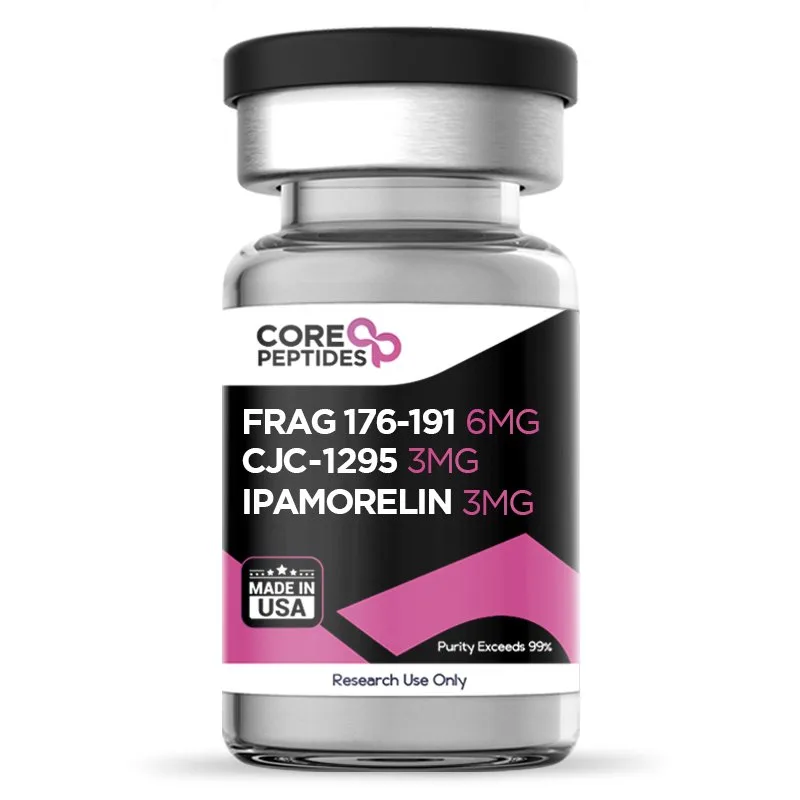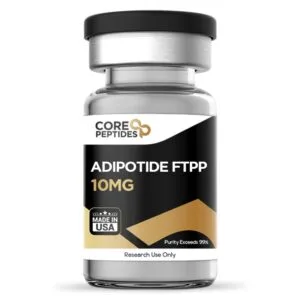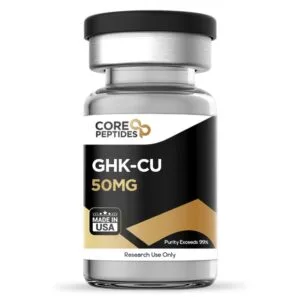Fragment 176-191 & CJC-1295 & Ipamorelin Blend (12mg)
$73.00
Size: 12mg
Contents: Fragment 176-191 (6mg), CJC-1295 NO DAC (3mg), Ipamorelin (3mg)
Form: Lyophilized powder
Purity: >99%
SKU: P-FRAGCJCIPAM-12
FREE Shipping on $200+ orders
Discount per Quantity
| Quantity | Discount | Price |
|---|---|---|
| 5 - 8 | 5% | $69.35 |
| 9 + | 10% | $65.70 |
Fragment 176-191 & CJC-1295 & Ipamorelin Peptide Blend
Researchers have suggested that growth hormone-releasing peptides (GHRPs), growth hormone secretagogues (GSHs), and analogs of growth hormones (hGH) may exhibit potential to promote growth hormone secretion. When combined, they have been suggested by researchers to exert significant action. These include increased fat metabolism, increased lean mass, regulated sleep cycle, and enhanced intestinal and cardiac functioning.
CJC-1295 is a synthetic peptide composed of 29 amino acids. The peptide appears to work by activating the Growth Hormone-Releasing Hormone (GHRH) receptors in the pituitary gland. These receptors are typically activated by the native GHRH. CJC-1295 appears to be a synthetic analog made of the first 29 amino acids from the GHRH sequence, which has additional modifications, including the replacement of four amino acids in its structure and the attachment of a Drug Affinity Complex (DAC) to potentially extend the pharmacokinetics of the peptide.
Ipamorelin is a synthetic pentapeptide and has been categorized by scientists as a growth hormone secretagogue (GHS). It has been posited to function similarly to Growth Hormone Releasing Peptides (GHRPs) and to potentially emulate the natural hunger hormone, ghrelin, particularly its potential to stimulate the release of hGH from the cells in the anterior pituitary gland. More specifically, Ipamorelin may mimic the function of ghrelin by activating the ghrelin receptors there, which are also known as the Growth Hormone Secretagogue receptors 1 Alpha (GHS-R1a)
Fragment 176-191 peptide, as the name suggests, is a small ‘fragment’ of the growth hormone hGH composed of 15 amino acids. This peptide might target the beta-3 adrenergic receptors (ADRB3), which may potentially induce weight loss downstream. Through these receptors, it is suggested that the peptide may boost fat burning in adipose tissue cells and possibly promote 'thermogenesis' in skeletal muscle cells.
Presented together, this blend may trigger a small portion of the pituitary gland, possibly stimulating the release of growth hormones. This blend has been posited by scientists to potentially synergistically enhance and regulate growth hormone concentration and maintain equilibrium levels.
Chemical Makeup(1)(2)(3)
Molecular formula
- Fragment 176-191: C78H125N23O23S2
- CJC-1295 (Mod GRF 1-29): C152H252N44O42
- Ipamorelin: C38H49N9O5
Molecular weight
- Fragment 176-191: 1817.12 g/mol
- CJC-1295 (Mod GRF 1-29): 3367.9 g/mol
- Ipamorelin: 711.8 g/mol
Other known titles
- Fragment 176-191: AOD 9604, GH (hGH) lipolytic fragment, Somatostatin (177-191), tyrosyl
- CJC-1295: Mod GRF 1-29, CJC-1295 without DAC
- Ipamorelin Ipamorelin Acetate, IPA
Research and Clinical Studies
Fragment 176-191 & CJC-1295 & Ipamorelin Blend, and Growth Hormones
While the fragment 176-191 appears to directly mimic the function of hGH, the peptides CJC-1295 and Ipamorelin appear to exert potential by upregulating the synthesis of hGH itself. For example, CJC-1295 has been suggested to have significant hGH-boosting potential in several phase-1 clinical trials.
In the first, test subjects aged between 20 and 40 were enrolled.(4) All subjects were divided into two groups – one was presented with a saline placebo and the rest with the CJC-1295 peptide. A blood sample was collected from all subjects before and after the peptide presentation. After completion of the study, it was reported by the researchers that the peptide group appeared to exhibit a 7.5-fold increase in their growth hormone levels compared to the standard group. The trend suggested that these hormones increased gradually throughout the study and remained unchanged for at least 7 days after discontinuing presentation.
Another study(5) was conducted on male test subjects aged between 20 and 60. Similar to the previous study, these subjects were divided into two groups – one was presented with a placebo while the rest were given the CJC-1295 peptide. The peptide group was given gradually increasing concentrations of the compound during the study. Upon analyzing the blood samples collected from these subjects, it was observed that there appeared to be a concentration-dependent increase, of up to 10 times, in the concentration of growth hormones among the peptide subjects. As per Madalina Ionescu et al., “The marked enhancement of trough GH levels by continuous GHRH stimulation implicates the importance of this effect on increasing IGF-I. Long-acting GHRH preparations may benefit patients with intact pituitary GH secretory capability.” (4)
Similarly, Ipamorelin has also been suggested to potentially increase hGH synthesis. In one clinical study it was posited that a single presentation of the peptide may boost hGH levels by over 60-fold compared to placebo.(6)
Fragment 176-191 & CJC-1295 & Ipamorelin Blend, and Lipolytic Action
A clinical trial(7) was conducted in 2004 to study the peptide’s potential lipolytic (fat-burning) action. In the trial, 300 subjects were enrolled and presented with the Fragment 176-191 peptide for 12 weeks. These subjects were divided into 6 groups – one given a saline placebo, and the rest presented with different peptide concentrations. The group presented with minimal peptide presence appeared to exhibit a notable reduction in their body weight (up to 2.8 kilograms). These peptides may have also helped improve these subjects’ cholesterol profiles and glucose tolerance levels. The research team stated, “The evidence from the trial is that over 12 weeks, [the peptide] induces competitive weight loss with accompanying health benefits…”
Fragment 176-191 & CJC-1295 & Ipamorelin Blend, and Regeneration
Thirty-two experimental rabbits were examined as part of this 2015 study,(8) all of whom were divided into four groups of eight. All four groups were presented with placebo, Fragment 176-191 peptide, hyaluronic acid, or a combination of the peptide and hyaluronic acid for about 7 weeks. After the completion of the study, all rabbits were checked for any signs of cartilage damage. Among all groups, the rabbits presented with peptide and hyaluronic acid combination appeared to show minimal cartilage degeneration. These results suggest that the peptide may have the capability to enhance cartilage regeneration and repair. The report concluded that “Intra-articular AOD9604 using ultrasound guidance enhanced cartilage regeneration, and combined AOD9604 and HA were more effective than HA or AOD9604 alone in the collagenase-induced knee OA rabbit model.” (8)
Fragment 176-191 & CJC-1295 & Ipamorelin Blend, and Body Composition
As mentioned, Fragment 176-191 may potentiate a favorable shift in body composition by reducing adiposity. Yet, CJC-1295 & Ipamorelin also appear to have a significant potential via different impacts, which may include increasing lean mass for CJC-1295, and increasing overall body weight in the case of Ipamorelin. Research in the lab suggests that Ipamorelin might potentially play a role in weight gain including muscle mass gain but also adiposity, possibly due to both an elevation in hGH levels and its potential to stimulate appetite through ghrelin receptor activation. An investigation into Ipamorelin's potential impact on body fat was conducted in both hGH-deficient and hGH-intact murine models. The results indicated that Ipamorelin may have led to a modest 15% rise in body weight within a span of 2 weeks. Additionally, in both murine models, there was a relative increase in fat pad weights when compared to overall body weight.(9)
On the other hand, CJC-1295 may potentially improve body composition while apparently increasing muscle mass without affecting or even possibly decreasing adiposity. Research involving murine models with a GHRH gene deletion (known as GHRHKO) noted that CJC-1295 might upregulate the synthesis of GH and potentially induce such a favorable shift in body composition. When these GHRHKO murine models were exposed to CJC-1295, they seemed to maintain standard lean mass, compared to unexposed models which failed to achieve normal lean mass. Moreover, the subcutaneous fat mass remained at control levels across all peptide-associated groups, while the GHRHKO murine models not exposed to CJC-1295 appeared to have increased adiposity.(10) Considering the potential lipolytic action of Fragment 176-191 and CJC-1295, researchers may want to consider the hypothesis that the blend of these peptides may counteract the fat-increasing potential of Ipamorelin, while further increasing its muscle building potential.
Fragment 176-191 & CJC-1295 & Ipamorelin Blend, and Bone Mineral Content
By increasing lean and muscle mass, the peptides and especially Ipamorelin may provide potential benefits in bone mass. In an experiment, murine subjects were either introduced to Ipamorelin or a control substance. The impact of Ipamorelin on bone mineral content was observed in real-time using dual X-ray absorptiometry (DXA) at select areas, notably the femur and L6 vertebrae. Following the study period, the femurs of the murine subjects were examined using mid-diaphyseal peripheral quantitative computed tomography (pQCT) scans. Preliminary results suggest that the peptide might have played a role in a possible weight increase and a potential rise in the tibial and vertebral bone mineral content as detected by DXA, compared to the control group. The pQCT findings hint that the increase in cortical BMC might be due to an expansion in the cross-sectional bone area.(11)
Fragment 176-191 & CJC-1295 & Ipamorelin Peptide Blend is available for research and laboratory purposes only. Please review and adhere to our Terms and Conditions before ordering.
References
- National Center for Biotechnology Information (2023). PubChem Compound Summary for CID 91976842, CJC1295 Without DAC. https://pubchem.ncbi.nlm.nih.gov/compound/CJC1295-Without-DAC
- National Center for Biotechnology Information (2023). PubChem Compound Summary for CID 9831659, Ipamorelin. https://pubchem.ncbi.nlm.nih.gov/compound/Ipamorelin
- National Center for Biotechnology Information (2023). PubChem Substance Record for SID 319360420, 386264-39-7, Source: ToxPlanet. https://pubchem.ncbi.nlm.nih.gov/substance/319360420
- Ionescu M, Frohman LA. Pulsatile growth hormone secretion (GH) persists during continuous stimulation by CJC-1295, a long-acting GH-releasing hormone analog. J Clin Endocrinol Metab. 2006 Dec;91(12):4792-7. doi: 10.1210/jc.2006-1702. Epub 2006 Oct 3. PMID: 17018654. https://pubmed.ncbi.nlm.nih.gov/17018654/
- Teichman SL, Neale A, Lawrence B, Gagnon C, Castaigne JP, Frohman LA. Prolonged stimulation of growth hormone (GH) and insulin-like growth factor I secretion by CJC-1295, a long-acting analog of GH-releasing hormone, in healthy adults. J Clin Endocrinol Metab. 2006 Mar;91(3):799-805. doi: 10.1210/jc.2005-1536. Epub 2005 Dec 13. PMID: 16352683. https://pubmed.ncbi.nlm.nih.gov/16352683/
- Gobburu, J. V., Agersø, H., Jusko, W. J., & Ynddal, L. (1999). Pharmacokinetic-pharmacodynamic modeling of ipamorelin, a growth hormone releasing peptide, in human volunteers. Pharmaceutical research, 16(9), 1412–1416. https://doi.org/10.1023/a:1018955126402
- News, Medical and Life Sciences, Obesity drug codenamed AOD 9604 highly successful in trials, 16 December 2004, https://www.news-medical.net/news/2004/12/16/6878.aspx
- Kwon DR, Park GY. Effect of Intra-articular Injection of AOD9604 with or without Hyaluronic Acid in Rabbit Osteoarthritis Model. Ann Clin Lab Sci. 2015 Summer;45(4):426-32. PMID: 26275694. https://pubmed.ncbi.nlm.nih.gov/26275694/
- Lall, S., Tung, L. Y., Ohlsson, C., Jansson, J. O., & Dickson, S. L. (2001). Growth hormone (GH)-independent stimulation of adiposity by GH secretagogues. Biochemical and biophysical research communications, 280(1), 132–138. https://doi.org/10.1006/bbrc.2000.4065
- Alba M, Fintini D, Sagazio A, Lawrence B, Castaigne JP, Frohman LA, Salvatori R. Once-daily administration of CJC-1295, a long-acting growth hormone-releasing hormone (GHRH) analog, normalizes growth in the GHRH knockout mouse. Am J Physiol Endocrinol Metab. 2006 Dec;291(6):E1290-4. doi: 10.1152/ajpendo.00201.2006. Epub 2006 Jul 5. PMID: 16822960.
- Svensson, J., Lall, S., Dickson, S. L., Bengtsson, B. A., Rømer, J., Ahnfelt-Rønne, I., Ohlsson, C., & Jansson, J. O. (2000). The GH secretagogues ipamorelin and GH-releasing peptide-6 increase bone mineral content in adult female rats. The Journal of endocrinology, 165(3), 569–577. https://doi.org/10.1677/joe.0.1650569





